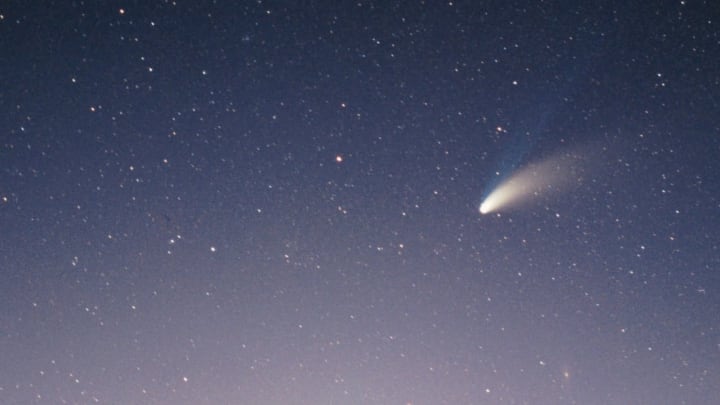Comet Hale-Bopp was a sensation in the mid-1990s. It was visible to the naked eye for 18 months, shattering a nine-month record previously set in 1811. It inspired a doomsday cult, wild late-night radio theories about extraterrestrials, and plenty of actual science. But a year before it became visible to normal observers, two men independently and simultaneously discovered it in a coincidence of astronomical proportions.
On the night of July 22-23, 1995, Alan Hale was engaged in his favorite hobby: looking at comets. It was the first clear night in his area for about 10 days, so he decided to haul out his telescope and see what he could see. In the driveway of his New Mexico home, he set up his Meade DS-16 telescope and located Periodic Comet Clark, a known comet. He planned to wait a few hours and observe another known comet (Periodic Comet d'Arrest) when it came into view. To kill time, he pointed his telescope at M70, a globular cluster in the Sagittarius system.

Hale was both an amateur astronomer and a professional. His interest in spotting comets was actually the amateur part, thought it would make his name famous. Hale's day jobs included stints at JPL in Pasadena and the Southwest Institute for Space Research in Cloudcroft, New Mexico. But that night, peering at M70, he wrote, "I immediately noticed a fuzzy object in the field that hadn't been there when I had looked at M70 two weeks earlier." He double-checked that he was looking in the right place, and then started to get excited.
In order to verify that the fuzzy object wasn't something astronomers already knew about, Hale consulted his deep-sky catalogues and also ran a computer search using the International Astronomical Union's computer at Harvard University. Convinced that he had found something new, Hale fired off an email very early on the morning of July 23 to the IAU's Central Bureau for Astronomical Telegrams, telling them what he had found, along with detailed instructions on how to verify it themselves. Hale also tracked the object as it moved, until it moved out of view. It was definitely a comet, and it was definitely new.
Meanwhile, Tom Bopp was in Arizona, also hunting for comets. At the time, Bopp was working at a construction materials company in Phoenix, but he was also an accomplished amateur astronomer, with decades of experience observing deep-sky objects. That night, Bopp vas visiting the remote Vekol Ranch, 90 miles south of Phoenix, known as a great location for dark-sky viewing. He was with a group of friends, which was important because Bopp didn't actually own a telescope.
The Bopp group looked through their various telescopes, observing all sorts of deep-sky objects late into the night. Bopp's friend Jim Stevens had set up his homemade 17.5-inch Dobsonian reflector telescope and made some observations. Stevens finished an observation, then left his telescope to consult a star atlas and figure out what to aim at next. While Stevens was occupied, Bopp peered into Stevens's telescope and saw a fuzzy object enter the field of view, near M70. He called his friends over to have a look.
The Bopp group proceeded to track the fuzzy object for several hours, just as Hale was doing over in New Mexico. By tracking its movement relative to background stars, they (like Hale) concluded that it was a comet. When the comet left his view, Bopp drove to a Western Union and sent a telegram to the Central Bureau for Astronomical Telegrams. (For historical perspective, telegrams were extremely outdated in 1995, but technically they were still a thing.)
Brian Marsden at the Central Bureau received Bopp's telegram hours later, after getting a few followup emails from Hale with additional details. Comparing the times of discovery, Marsden realized that the two men had discovered the comet simultaneously. According to NASA, it was the farthest comet ever to be discovered by amateur astronomers—it was 7.15 Astronomical Units (AU) from our sun. That's 665 million miles. Not bad for a pair of amateurs, one using a homemade telescope!
The Central Bureau verified the findings and about 12 hours after the initial discovery, issued IAU Circular 6187, designating it C/1995 O1 Hale-Bopp. The circular read, in part: "All observers note the comet to be diffuse with some condensation and no tail, motion toward the west-northwest."

Less than a year later, Comet Hale-Bopp came into plain view, and the rest is history. It was a thousand times brighter than Halley's Comet, which had caused a major stir in its most recent appearance in the 1980s. Comet Hale-Bopp will return, much like Halley's Comet, but it won't be until the year 4385. (And incidentally, it was previously visible circa 2200 BCE.)
